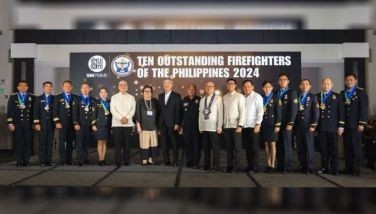Suite inspirations and a garden of verses

October 22, 2001 | 12:00am
 Two of Dumaguete City’s writing sons released a book each last September, both published by Giraffe: Bobby Flores Villasis’ Suite Bergamasque: The Boulevard Stories and Ernesto Superal Yee’s latest collection of poems, About My Garden.
Two of Dumaguete City’s writing sons released a book each last September, both published by Giraffe: Bobby Flores Villasis’ Suite Bergamasque: The Boulevard Stories and Ernesto Superal Yee’s latest collection of poems, About My Garden.
Villasis and Yee have been described as two-thirds of the triumvirate currently running the annual summer writers workshop that is like a rite of passage for those in the craft. The obscure, but no less quixotic third is Cesar Ruiz Aquino, whose had fiction and poetry published by different publishing houses in the early ’90s.
The forewords for the Villasis and Yee books were written by the same author, Rowena Tiempo Torrevillas, now Iowa-based but Dumaguete-bred, herself the third corner of the Tiempo writing triumvirate after the husband and wife Tiempo writing team that founded the workshop in the south.
Torrevillas can understand only too well the various foibles and demons the likes of Villasis and Yee have to wrestle with; in their small southern city, everyone knows practically everybody, and the daily seemingly humdrum concerns could well be a microcosm of a greater conflict or perhaps interplay between suites and gardens.
Villasis once acted the title role of King Lear in the Shakespeare play of the same name, with Torrevillas essaying the role of Cordelia; what better combination could there be at the Luce Auditorium?
(An aside: In the same play in the early ’80s, Aquino was the Earl of Kent or some such trusted aide whose loyalty only landed him in the stocks).
One can well remember the famous final scene where Lear-Villasis holds the dying Cordelia-Torrevillas in his arms, the theater so silent one can hear the breathing of crickets, which would have done Shakespeare proud. The two go back a long way, maybe as far as back as the Bard.
Villasis has already established himself as a writer not only in Dumaguete but also on the national stage, having a good number of Palanca awards as well as Free Press and Graphic prizes. He started off as a playwright, and was much involved in theater productions like the aforementioned King Lear, and his ear for dialogue comes into good stead in his stories set mainly on Dumaguete’s boulevard, an area rich in romance and decadence. Now we get to zoom in on the lives of these old rich, although there is the usual warning that any similarity to persons dead or living is purely coincidental. But any Dumaguete old-timer might recognize a person or two on which a particular character is based, the fictionist weaving a composite magic.
So we have: the desolate Menandro who, after his flight attendant-daughters die in separate plane crashes and his wife subsequently leaves him, seeks solace in the friendship of a streetwalker on the boulevard, a scene that might have turned out trite in the hands of a lesser writer.
Villasis however is able to rein in even the reader’s emotions, and the Menandro character, in the vein of De Niro in Taxi Driver, is in the end able to subscribe to a deliverance that is violent and not entirely unexpected.
In the title story, Villasis recounts the moral tale of a native daughter come home to roost, with the virulent and impersonal sex scene in the wind-up a counterpoint to the preliminary, painstaking descriptions of the genteel lifestyle.
In telling the stories, forever intertwined, of the boulevard folk, Villasis never condemns, never hoists a moral superiority over his fiction. What the author has is an indefatigable compassion, almost as if he is part of his doomed subjects as well.
But doomed only in the sense that any redemption is not immediately at hand, as in the seeming taong grasa in the fallen ilustrado of the "Looking at Hecla" protagonist, doesn’t she remind you of ....?
Aquino, the triumvirate’s third, once wrote: Any similarity to persons living or dead is purely intentional; only the reader is imaginary.
Villasis too might have had that in mind when writing some of these stories, which have recurring characters who weave in and out, playing the main part in one only to fade into the background in the next, and vice versa.
In a sense too Villasis’ boulevard acquires the mythic dimensions of Garcia Marquez’s Macondo with its town plaza of dusty almond trees.
As for Yee, lawyer and piano player, he again displays his fine form in this his third collection for Giraffe, after last year’s fiction selection Ember Days and the poetry volume, Covenants.
Torrevillas noted Yee’s predilection for triads in his imagery, much like the musician thumping out his chords on the keyboard – always in threes.
In the poet Yee’s work there is no need to be flowery: the garden of what he tends is what you see is what you get. He writes poems the way he plays the piano.
It seems that the poems in About My Garden were written in a single burst of inspiration or madness, with the writer going back to them later to chisel and round out the rough edges, so that what comes out is a jewel of memory of our little town down south that refracts light in varied ways, with ships coming and going in the distance, their horns a disjointed lament.
BrandSpace Articles
<
>



















